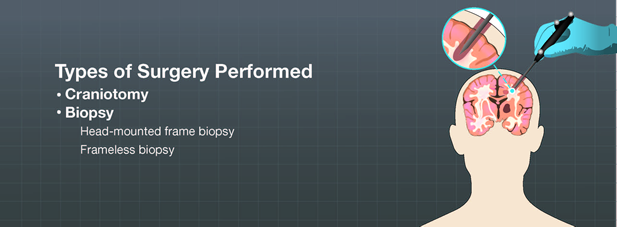
Open surgery is the most common treatment option for brain tumors. A craniotomy is performed to remove a brain tumor or to halt its progress.
There a few types of surgery performed to remove or treat a brain tumor:
Other important terms to know related to brain tumor surgery:
Complete Removal—Sometimes called a “gross total resection” is when the surgeon removes the entire tumor. It is possible that some tumor cells may remain, but they are not visible to the human eye, cannot be seen by a surgical microscope, or is not visible on MRI after resection. Your doctor will be able to discuss the potential of re-growth and if additional treatment is needed.
Debulking—This term means that the entire tumor was not removed. “Debulk” means to surgically reduce the size of the tumor by removing as much of it as possible. You may hear your surgeon say the tumor was “debulked’ or the patient underwent a “debulking” which means that a tumor was surgically made smaller.
Partial Removal—If the surgeon feels there may be risk of neurological damage, they may choose to remove only a part of the brain tumor.
Ommaya Reservoir—A surgical container, implanted under the scalp, has an attached tube that is used to deliver chemotherapy to the brain, remove cerebrospinal fluid to check for abnormal cells, or remove cystic fluid. This can be built into a catheter as part of a shunt, or it can work on its own.
Shunt—Pressure may build up in the skull with the presence of excess fluid in the brain or fluid pathways blocked by brain swelling. This can be treated with a shunt which is a tube draining the fluid in the brain and putting in somewhere else in the body, most commonly the abdomen or belly.
Skull Base Surgery—Your skull base is the delicate bony area that supports the bottom of your brain. This area contains nerves and blood vessels that are responsible for vision, smell, hearing, speech, swallowing, and facial movements. This type of surgery may be lengthy as the surgeon may need to remove and reassemble the bone surrounding the brain without disrupting the crucial nerves or blood vessels located in this area.
Transphenoidal Surgery—This type of surgery is used most commonly to treat pituitary adenomas and craniopharyngiomas. “Trans” means through and “sphenoid’ refers to the sphenoid bone located under the eyes and over the nose. A surgeon will usually make their entry under the upper lip or through the nostril to access the pituitary gland.
Laser Interstitial Thermal Therapy (LITT)—This is a new option that is available in only a few places and an MRI and laser are used in this type of treatment. The brain tumor is targeted with a laser that heats and destroys the tumor tissue; all while being monitored by an MRI so this technique can be done in real time. LITT uses stereotactic techniques to target the tumor with one or more small holes.